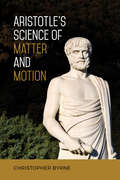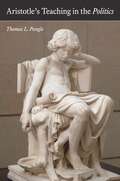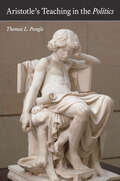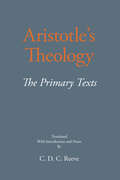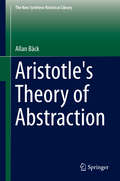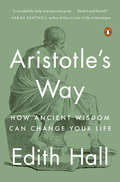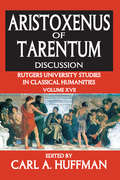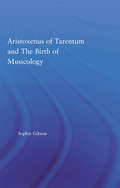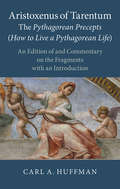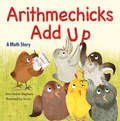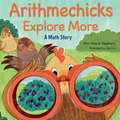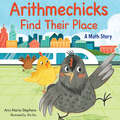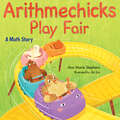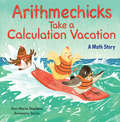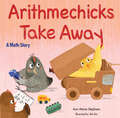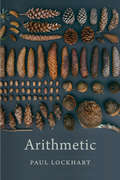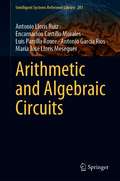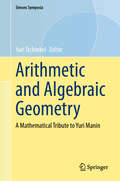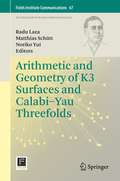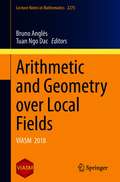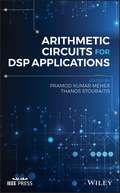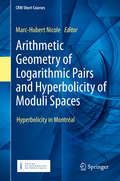- Table View
- List View
Aristotle's Science of Matter and Motion
by Christopher ByrneAlthough Aristotle’s contribution to biology has long been recognized, there are many philosophers and historians of science who still hold that he was the great delayer of natural science, calling him the man who held up the Scientific Revolution by two thousand years. They argue that Aristotle never considered the nature of matter as such or the changes that perceptible objects undergo simply as physical objects; he only thought about the many different, specific natures found in perceptible objects. Aristotle’s Science of Matter and Motion’s focus is on refuting this misconception, arguing that Aristotle actually offered a systematic account of matter, motion, and the basic causal powers found in all physical objects. Author, Christopher Byrne sheds lights on Aristotle’s account of matter, revealing how Aristotle maintained that all perceptible objects are ultimately made from physical matter of one kind or another, accounting for their basic common features. For Aristotle, then, matter matters a great deal.
Aristotle's Teaching in the Politics
by Thomas L. PangleWith Aristotle's Teaching in the "Politics," Thomas L. Pangle offers a masterly new interpretation of this classic philosophical work. It is widely believed that the Politics originated as a written record of a series of lectures given by Aristotle, and scholars have relied on that fact to explain seeming inconsistencies and instances of discontinuity throughout the text. Breaking from this tradition, Pangle makes the work's origin his starting point, reconceiving the Politics as the pedagogical tool of a master teacher. With the Politics, Pangle argues, Aristotle seeks to lead his students down a deliberately difficult path of critical thinking about civic republican life. He adopts a Socratic approach, encouraging his students--and readers--to become active participants in a dialogue. Seen from this perspective, features of the work that have perplexed previous commentators become perfectly comprehensible as artful devices of a didactic approach. Ultimately, Pangle's close and careful analysis shows that to understand the Politics, one must first appreciate how Aristotle's rhetorical strategy is inextricably entwined with the subject of his work.
Aristotle's Teaching in the Politics
by Thomas L. PangleWith Aristotle’s Teaching in the “Politics,” Thomas L. Pangle offers a masterly new interpretation of this classic philosophical work. It is widely believed that the Politics originated as a written record of a series of lectures given by Aristotle, and scholars have relied on that fact to explain seeming inconsistencies and instances of discontinuity throughout the text. Breaking from this tradition, Pangle makes the work’s origin his starting point, reconceiving the Politics as the pedagogical tool of a master teacher.With the Politics, Pangle argues, Aristotle seeks to lead his students down a deliberately difficult path of critical thinking about civic republican life. He adopts a Socratic approach, encouraging his students—and readers—to become active participants in a dialogue. Seen from this perspective, features of the work that have perplexed previous commentators become perfectly comprehensible as artful devices of a didactic approach. Ultimately, Pangle’s close and careful analysis shows that to understand the Politics, one must first appreciate how Aristotle’s rhetorical strategy is inextricably entwined with the subject of his work.
Aristotle's Theology: The Primary Texts (The New Hackett Aristotle)
by Aristotle"Even those already familiar with Aristotle may be surprised to learn that discussions of theological topics can be found in so many of his works. Reeve's idea of packaging these texts sequentially along with commentary and notes is brilliant. This book will be essential reading for anyone interested in Aristotle's theology."—S. Marc Cohen,Professor of Philosophy, Emeritus, University of Washington
Aristotle's Theory of Abstraction (The New Synthese Historical Library #73)
by Allan BäckThis book investigates Aristotle's views on abstraction and explores how he uses it. In this work, the author follows Aristotle in focusing on the scientific detail first and then approaches the metaphysical claims, and so creates a reconstructed theory that explains many puzzles of Aristotle's thought. Understanding the details of his theory of relations and abstraction further illuminates his theory of universals. Some of the features of Aristotle's theory of abstraction developed in this book include: abstraction is a relation; perception and knowledge are types of abstraction; the objects generated by abstractions are relata which can serve as subjects in their own right, whereupon they can appear as items in other categories. The author goes on to look at how Aristotle distinguishes the concrete from the abstract paronym, how induction is a type of abstraction which typically moves from the perceived individuals to universals and how Aristotle's metaphysical vocabulary is "relational. ' Beyond those features, this work also looks at how of universals, accidents, forms, causes and potentialities have being only as abstract aspects of individual substances. An individual substance is identical to its essence; the essence has universal features but is the singularity making the individual substance what it is. These theories are expounded within this book. One main attraction in working out the details of Aristotle's views on abstraction lies in understanding his metaphysics of universals as abstract objects. This work reclaims past ground as the main philosophical tradition of abstraction has been ignored in recent times. It gives a modern version of the medieval doctrine of the threefold distinction of essence, made famous by the Islamic philosopher, Avicenna.
Aristotle's Theory of Contrariety (International Library of Philosophy)
by J.P. AntonFirst published in 2000. Routledge is an imprint of Taylor & Francis, an informa company.
Aristotle's Way: How Ancient Wisdom Can Change Your Life
by Edith HallFrom renowned classicist Edith Hall, ARISTOTLE'S WAY is an examination of one of history's greatest philosophers, showing us how to lead happy, fulfilled, and meaningful livesAristotle was the first philosopher to inquire into subjective happiness, and he understood its essence better and more clearly than anyone since. According to Aristotle, happiness is not about well-being, but instead a lasting state of contentment, which should be the ultimate goal of human life. We become happy through finding a purpose, realizing our potential, and modifying our behavior to become the best version of ourselves. With these objectives in mind, Aristotle developed a humane program for becoming a happy person, which has stood the test of time, comprising much of what today we associate with the good life: meaning, creativity, and positivity. Most importantly, Aristotle understood happiness as available to the vast majority us, but only, crucially, if we decide to apply ourselves to its creation--and he led by example. As Hall writes, "If you believe that the goal of human life is to maximize happiness, then you are a budding Aristotelian."In expert yet vibrant modern language, Hall lays out the crux of Aristotle's thinking, mixing affecting autobiographical anecdotes with a deep wealth of classical learning. For Hall, whose own life has been greatly improved by her understanding of Aristotle, this is an intensely personal subject. She distills his ancient wisdom into ten practical and universal lessons to help us confront life's difficult and crucial moments, summarizing a lifetime of the most rarefied and brilliant scholarship.
Aristoxenus of Tarentum: Texts and Discussion
by Carl HuffmanAristoxenus of Tarentum was reported to have been bitterly disappointed when Theophrastus was chosen instead of him to succeed Aristotle as the head of the Peripatetic School. He had a truly phenomenal output of some 453 volumes, most of which survive only in fragments. He was the most famous music theorist in antiquity and came to be referred to simply as "the musician." In addition, he was a founder of Greek biography and wrote the life histories of Pythagoras, Archytas, Socrates, and Plato among others. This volume includes eleven selections, which are almost evenly divided between his work in music theory and biography. There is a chapter on his general biographical method as well as chapters on his specific treatments of the Pythagoreans, Socrates, and Plato. There are chapters evaluating the extent to which Aristoxenus was a historian of music, his account of music therapy, his views on musical "character," the use of instruments and empiricism in his harmonic theory, and his relation to the "Neoclassical" Greek composers of the fourth century. This volume includes: "Did Aristoxenus Write Musical History?, " Andrew Barker; "Instruments and Empiricism in Aristoxenus' Elementa harmonica," David Creese; "Aristoxenus and Musical Ethos," Eleonora Rocconi; "Aristoxenus and Music Therapy: Fr. 26 Wehrli Within the Tradition on Music and Catharsis," Antonella Provenza; "Aristoxenus and the "Neoclassicists," Timothy Power; "Apollonius on Theophrastus on Aristoxenus," William W. Fortenbaugh; "Aristoxenus' Biographical Method," Stefan Schorn; "Aristoxenus and the Pythagoreans," Leonid Zhmud; "Aristoxenus' Life of Socrates," Carl A. Huffman; "Aristoxenus' Life of Plato," John Dillon; and "Aristoxenus and the Early Academy," Andrew Barker. Spanning close to three full decades, Transaction's Rutgers University Studies in Classical Humanities Series continues to pioneer in the field of classical studies.
Aristoxenus of Tarentum and the Birth of Musicology (Studies in Classics #Vol. 9)
by Sophie GibsonAristoxenus made an enormous contribution to the development of music theory in antiquity. Despite his Pythagorean upbringing, he rejected Pythagorean methods of harmonics which focused on the mathematical significance of musical structures and instead applied a scientific methodology appropriated from Aristotle. This volume studies the theories of Aristoxenus.
Aristoxenus of Tarentum (How to Live a Pythagorean Life): An Edition of and Commentary on the Fragments with an Introduction
by Carl A. HuffmanThe Pythagorean Precepts by Aristotle's pupil, Aristoxenus of Tarentum, present the principles of the Pythagorean way of life that Plato praised in the Republic. They are our best guide to what it meant to be a Pythagorean in the time of Plato and Aristotle. The Precepts have been neglected in modern scholarship and this is the first full edition and translation of and commentary on all the surviving fragments. The introduction provides an accessible overview of the ethical system of the Precepts and their place not only in the Pythagorean tradition but also in the history of Greek ethics as a whole. The Pythagoreans thought that human beings were by nature insolent and excessive and that they could only be saved from themselves if they followed a strictly structured way of life. The Precepts govern every aspect of life, such as procreation, abortion, child rearing, friendship, religion, desire and even diet.
Arithmechicks Add Up: A Math Story (Arithmechicks)
by Ann Marie StephensThis exuberant picture book demonstrates key math concepts to children as ten math-loving chicks make a new friend.As the Arithmechicks slide down the slide, swing on the swings, and play hide-and-seek, they don't realize that a lonely mouse is copying them, longing to join in. However, when their basketball becomes stuck, the chicks discover that a two-inch-tall new friend is exactly what they need. In this heartwarming story, there are many ways to add up ten cheerful chicks--but a new friend is what makes them cheer. The book includes a helpful glossary that defines the eight arithmetic strategies the chicks use throughout the story, providing a playful introduction to essential math for young children and their caregivers.
Arithmechicks Explore More: A Math Story (Arithmechicks #5)
by Ann Marie StephensThe Arithmechicks prove that love is greater than disappointment in this heartwarming story about a hike, a lost stuffed animal, and the math concepts of greater than, less than, and equal to.Publishers Weekly described the Arithmechicks as an &“enjoyable resource for young ones stepping up their counting game."Join the Arithmechicks and Mouse as they head off to the wilderness! These chicks can&’t wait to hike up the ridge, find delicious berries, and, best of all, spend time with their duckling cousins! But the day is off to a bad start when one duckling accidentally leaves a beloved stuffed animal on the bus. How can these chicks (and Mouse) cheer up their cousin? Discover how an adventure with the Arithmechicks brings both humor and heart to the math they stumble across during their journey. Ann Marie Stephens draws upon thirty years of teaching experience to ensure that readers absorb math while having fun. The book also includes a helpful glossary that defines the modern arithmetic strategies the chicks use throughout the story.Join the Arithmechicks on all of their math adventures! Readers will explore addition in Arithmechicks Add Up, subtraction in Arithmechicks Take Away, fact families in Arithmechicks Take a Calculation Vacation, fractions in Arithmechicks Play Fair, greater than/less than/equal to in Arithmechicks Explore More, and ordinal numbers in Arithmechicks Find Their Place.
Arithmechicks Find Their Place: A Math Story (Arithmechicks #6)
by Ann Marie StephensJoin the Arithmechicks on a mathematical adventure in the big city! Help them solve a mystery in this playful picture book that demonstrates the concept of ordinal numbers in a clever story featuring ten math-loving chicks. Publishers Weekly described the Arithmechicks as an &“enjoyable resource for young ones stepping up their counting game."The Arithmechicks and Mouse are excited to be traveling to the city—even more so when they learn that Mama has planned a secret scavenger hunt, culminating in a mysterious 10th stop! But when one chick wants to be the best, he starts disrupting the plans. How can these frustrated chicks (and Mouse) show their sibling that it&’s better to work together? This adventure with the Arithmechicks is made up of math, a mystery, and, most of all, humor and heart. Ann Marie Stephens draws upon thirty years of teaching experience to ensure that readers absorb math while having fun. The book also includes a helpful glossary that defines the modern arithmetic strategies the chicks use throughout the story.Join the Arithmechicks on all of their math adventures! Readers will explore addition in Arithmechicks Add Up, subtraction in Arithmechicks Take Away, fact families in Arithmechicks Take a Calculation Vacation, greater than/less than/equal to in Arithmechicks Explore More, fractions in Arithmechicks Play Fair, and ordinal numbers in Arithmechicks Find Their Place.
Arithmechicks Play Fair: A Math Story (Arithmechicks)
by Ann Marie StephensThis playful picture book demonstrates the concept of fractions in a story featuring the Arithmechicks, 10 math-loving chicks.Join the Arithmechicks and Mouse as they head off to the fair! These chicks can&’t wait to enjoy the roller coaster, bumper cars, games, and delicious snacks; meanwhile Mouse is determined to sink the rooster at the dunk tank. As the Arithmechicks explore the fair, they find ways to show how fractions work in the world. But when one chick doesn&’t get to select an activity, the day doesn&’t go according to plan until the chicks decide they all need to play fair. This book includes a helpful glossary with further information about fractions, while the story provides an exuberant introduction to essential math for young children and their caregivers.
Arithmechicks Take a Calculation Vacation: A Math Story (Arithmechicks)
by Ann Marie StephensThis playful picture book demonstrates key math concepts to children in a merry story featuring the Arithmechicks, ten math-loving chicks. The Arithmechicks are headed to the beach! Their good friend Mouse is going to compete in a sandcastle contest. The chicks are excited to play all sorts of beach games—including volleyball and surfing—as they cheer on Mouse. Readers are invited to add and subtract as these math-loving chicks also explore fact families—and to watch as Mouse, along with their new friend Crab, create a magnificent sandcastle! Will they win a prize? This book includes a helpful glossary that defines fact families, providing a playful introduction to essential math for young children and their caregivers.
Arithmechicks Take Away: A Math Story (Arithmechicks)
by Ann Marie StephensThis playful picture book demonstrates key math concepts to children in a merry story featuring the Arithmechicks, ten math-loving chicks.The Arithmechicks have invited their new friend Mouse for a sleepover. When Mama says it's time for bed, the clever chicks decide it's time to prolong the fun instead! During the story, readers are invited to count and take away during everyone's favorite game of hide-and-seek—and to find Mouse, who hides in a different place in each illustration -- until all settle down for bed in the warm, cozy conclusion. The book is the perfect introduction to essential math for young children and their caregivers. It includes a helpful glossary that defines the eight arithmetic strategies the chicks use throughout the story.
Arithmetic
by Paul LockhartPaul Lockhart reveals arithmetic not as the rote manipulation of numbers but as a set of ideas that exhibit the surprising behaviors usually reserved for higher branches of mathematics. In this entertaining survey, he explores the nature of counting and different number systems—Western and non-Western—and weighs the pluses and minuses of each.
Arithmetic 4 Work-text
by Judy HoweThis colorful workbook reviews facts and concepts learned in previous grades before moving on to new material. Concepts covered in Grade 4 include: multiplying and dividing by two-digit numbers, estimation, square measures, writing decimals as fractions, and simple geometry. A major emphasis is working with proper and improper fractions-adding, subtracting, multiplying, and finding the least common denominator.
Arithmetic and Algebraic Circuits (Intelligent Systems Reference Library #201)
by Antonio Lloris Ruiz Encarnación Castillo Morales Luis Parrilla Roure Antonio García Ríos María José Lloris MeseguerThis book presents a complete and accurate study of arithmetic and algebraic circuits. The first part offers a review of all important basic concepts: it describes simple circuits for the implementation of some basic arithmetic operations; it introduces theoretical basis for residue number systems; and describes some fundamental circuits for implementing the main modular operations that will be used in the text. Moreover, the book discusses floating-point representation of real numbers and the IEEE 754 standard. The second and core part of the book offers a deep study of arithmetic circuits and specific algorithms for their implementation. It covers the CORDIC algorithm, and optimized arithmetic circuits recently developed by the authors for adders and subtractors, as well as multipliers, dividers and special functions. It describes the implementation of basic algebraic circuits, such as LFSRs and cellular automata. Finally, it offers a complete study of Galois fields, showing some exemplary applications and discussing the advantages in comparison to other methods. This dense, self-contained text provides students, researchers and engineers, with extensive knowledge on and a deep understanding of arithmetic and algebraic circuits and their implementation.
Arithmetic and Algebraic Geometry: A Mathematical Tribute to Yuri Manin (Simons Symposia)
by Yuri TschinkelThis book is a tribute to the memory of Yuri Ivanovich Manin, who passed away on January 7, 2023. Manin was one of the giants of modern mathematics. His work covered a wide range of fields, including logic, number theory, geometry, mathematical physics, theoretical computer science, and linguistics. The contributions collected here are on topics close to his life-long passion: arithmetic and algebraic geometry.
Arithmetic and Geometry
by Luis Dieulefait Gerd Faltings D. R. Heath-Brown Yu. V. Manin B. Z. Moroz Jean-Pierre WintenbergerThe 'Arithmetic and Geometry' trimester, held at the Hausdorff Research Institute for Mathematics in Bonn, focussed on recent work on Serre's conjecture and on rational points on algebraic varieties. The resulting proceedings volume provides a modern overview of the subject for graduate students in arithmetic geometry and Diophantine geometry. It is also essential reading for any researcher wishing to keep abreast of the latest developments in the field. Highlights include Tim Browning's survey on applications of the circle method to rational points on algebraic varieties and Per Salberger's chapter on rational points on cubic hypersurfaces.
Arithmetic and Geometry of K3 Surfaces and Calabi–Yau Threefolds (Fields Institute Communications #67)
by Matthias Schütt Radu Laza Noriko YuiIn recent years, research in K3 surfaces and Calabi-Yau varieties has seen spectacular progress from both arithmetic and geometric points of view, which in turn continues to have a huge influence and impact in theoretical physics--in particular, in string theory. The workshop on Arithmetic and Geometry of K3 surfaces and Calabi-Yau threefolds, held at the Fields Institute (August 16-25, 2011), aimed to give a state-of-the-art survey of these new developments. This proceedings volume includes a representative sampling of the broad range of topics covered by the workshop. While the subjects range from arithmetic geometry through algebraic geometry and differential geometry to mathematical physics, the papers are naturally related by the common theme of Calabi-Yau varieties. With the big variety of branches of mathematics and mathematical physics touched upon, this area reveals many deep connections between subjects previously considered unrelated. Unlike most other conferences, the 2011 Calabi-Yau workshop started with 3 days of introductory lectures. A selection of 4 of these lectures is included in this volume. These lectures can be used as a starting point for the graduate students and other junior researchers, or as a guide to the subject.
Arithmetic and Geometry over Local Fields: VIASM 2018 (Lecture Notes in Mathematics #2275)
by Bruno Anglès Tuan Ngo DacThis volume introduces some recent developments in Arithmetic Geometry over local fields. Its seven chapters are centered around two common themes: the study of Drinfeld modules and non-Archimedean analytic geometry. The notes grew out of lectures held during the research program "Arithmetic and geometry of local and global fields" which took place at the Vietnam Institute of Advanced Study in Mathematics (VIASM) from June to August 2018. The authors, leading experts in the field, have put great effort into making the text as self-contained as possible, introducing the basic tools of the subject. The numerous concrete examples and suggested research problems will enable graduate students and young researchers to quickly reach the frontiers of this fascinating branch of mathematics.
Arithmetic Circuits for DSP Applications
by Thanos Stouraitis Pramod Kumar MeherA comprehensive guide to the fundamental concepts, designs, and implementation schemes, performance considerations, and applications of arithmetic circuits for DSP Arithmetic Circuits for DSP Applications is a complete resource on arithmetic circuits for digital signal processing (DSP). It covers the key concepts, designs and developments of different types of arithmetic circuits, which can be used for improving the efficiency of implementation of a multitude of DSP applications. Each chapter includes various applications of the respective class of arithmetic circuits along with information on the future scope of research. Written for students, engineers, and researchers in electrical and computer engineering, this comprehensive text offers a clear understanding of different types of arithmetic circuits used for digital signal processing applications. The text includes contributions from noted researchers on a wide range of topics, including a review of circuits used in implementing basic operations like additions and multiplications; distributed arithmetic as a technique for the multiplier-less implementation of inner products for DSP applications; discussions on look up table-based techniques and their key applications; CORDIC circuits for calculation of trigonometric, hyperbolic and logarithmic functions; real and complex multiplications, division, and square-root; solution of linear systems; eigenvalue estimation; singular value decomposition; QR factorization and many other functions through the use of simple shift-add operations; and much more. This book serves as a comprehensive resource, which describes the arithmetic circuits as fundamental building blocks for state-of-the-art DSP and reviews in - depth the scope of their applications.
Arithmetic Geometry of Logarithmic Pairs and Hyperbolicity of Moduli Spaces: Hyperbolicity in Montréal (CRM Short Courses)
by Marc-Hubert NicoleThis textbook introduces exciting new developments and cutting-edge results on the theme of hyperbolicity. Written by leading experts in their respective fields, the chapters stem from mini-courses given alongside three workshops that took place in Montréal between 2018 and 2019. Each chapter is self-contained, including an overview of preliminaries for each respective topic. This approach captures the spirit of the original lectures, which prepared graduate students and those new to the field for the technical talks in the program. The four chapters turn the spotlight on the following pivotal themes:The basic notions of o-minimal geometry, which build to the proof of the Ax–Schanuel conjecture for variations of Hodge structures;A broad introduction to the theory of orbifold pairs and Campana's conjectures, with a special emphasis on the arithmetic perspective;A systematic presentation and comparison between different notions of hyperbolicity, as an introduction to the Lang–Vojta conjectures in the projective case;An exploration of hyperbolicity and the Lang–Vojta conjectures in the general case of quasi-projective varieties.Arithmetic Geometry of Logarithmic Pairs and Hyperbolicity of Moduli Spaces is an ideal resource for graduate students and researchers in number theory, complex algebraic geometry, and arithmetic geometry. A basic course in algebraic geometry is assumed, along with some familiarity with the vocabulary of algebraic number theory.
